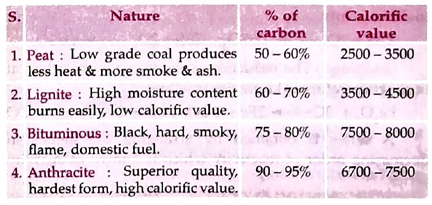Fuels
Fuels
A substance that can supply energy either alone or by reacting with another substance is known as fuel. Heat produced by fuel is measured in Calories. An ideal fuel should
1. have high calorific value
2. be cheap and easily available
3. be easily stored & transport
4. be regulated and controlled
5. have low ignition temperature
The quantity of fuel is expressed in the form of calorific value.
Calorific value is the total quantity of heat liberated by complete combustion of a unit mass of fuel in air or oxygen.
Calorific value of fuels are expressed in kcal/m³ or British Thermal Unit (B.T.U) per cubic foot.
1 kcal/m³ = 0.107 B.T.U/ft³
Fuel: may be solid (e.g wood, coal etc.)
Liquid (e.g kerosene oil, petroleum, alcohol etc.) or gas (e.g water gas, producer gas, coal gas, oil gas, natural gas, gobar gas, LPG etc.) However, gaseous fuel are considered to be the best fuels.
1. Water gas (syn gas): It is a mixture of carbon monoxide and hydrogen. It is obtained by the action of steam on a red hot coke at 1000° C.
C + H2O → CO + H2 — 28 kcal
Water gas
Producer gas: It is a mixture of CO and N₂. It is prepared by burning coke in limited supply of air. It is the cheapest gaseous fuel, however its calorific value is not very high because it has a large proportion of nitrogen.
Coal gas: It is a mixture of H2, CH4, CO and other; gases like N2, C2H4,O2 etc. It is obtained by destructive distillation of coal at about 1000°C.
Oil gas : It is a mixture of H2, CH4, C2H4, CO and other gases like CO2. It is obtained by thermal cracking of kerosene oil. It is used in laboratories.
Gobar gas: It contains CH4, CO and H2. It is produced by fermentation of gobar in absence of air. It is used as a domestic fuel in villages.
Natural gas: It is a mixture of gaseous hydrocarbons viz methane 85%, ethane, propane butane etc. Liquefied petroleum mainly butane and isobutane.
LPG and CNG (Petroleum Gases)
Liquified Petroleum Gas (LPG): The petroleum gas liquified under pressure is called liquified petroleum gas. It is a mixture of butane and isobutane with small amount of propane and is easily compressed under pressure as liquid and stored in iron cylinders. It is used as domestic fuel.
The stench due to leakage from LPG Cylinder is because of Ethyl mercaptan.
Compressed Natural Gas (CNG): The natural gas compressed at very high pressure is called compressed natural gas (CNG). It consists mainly of methane (95%) which is a relatively unreactive hydrocarbons and make it nearly complete combustion possible. The other 5% is made of various gases such that ethane, propane and butane including small amount of other gases N2, CO2, H2S, water vapour etc. The CNG is now being used as a better fuel than gasoline for running buses, cars and three-wheelers in metropolitan cities like Delhi, Mumbai etc, because of its complete combustion and no unburnt carbon is being released in the atmosphere to cause air pollution.
Knocking and Octane Number: The metallic sound produced due to irregular burning of the fuel is known as knocking. The knocking lowers the efficiency of the engine and results the loss of energy. A fuel which has minimum knocking property is always preferred. It has been observed that the straight chain aliphatic hydrocarbons have a higher tendency to knock while branched or unsaturated hydrocarbons have less tendency to knock.
To indicate the quality of gasoline (petrol), a method of gradation has been introduced which is termed octane rating or octane number. Two compounds heptane and isooctane have been taken as standard. Heptane which causes maximum knocking is assigned to octane number zero and iso-octane which causes minimum knocking is assigned the octane number 100.

Antiknock Compounds: To reduce the knocking property or to improve the octane number of a fuel certain chemicals are added it. These are called antiknock compounds. TEL (Tetra Ethyl Lead) is the best antiknock compound.
Cetane Number: Cetane number of a diesel oil is the percentage of cetane (hexadecane) by volume in a mixture of cetane and α-methyl naphthalene. Hexa decane has been assigned cetane number 100 while a-methyl nephthalene is assigned zero cetane number.
The diesel oil having cetane number 75 would have same ignition property as a mixture of 75% cetane and 25% α-methyl naphthalene.
Flash Point: The lowest temperature at which an oil gives sufficient vapours to form an explosive mixture with air is known as flash point of the oil. The flash point in India is fixed at 44°C.
Coal: On the basis of carbon % and calorific value there are four types of coal.

Follow on Facebook page – Click Here
Google News join in – Click Here
Read More Asia News – Click Here
Read More Sports News – Click Here
Read More Crypto News – Click Here